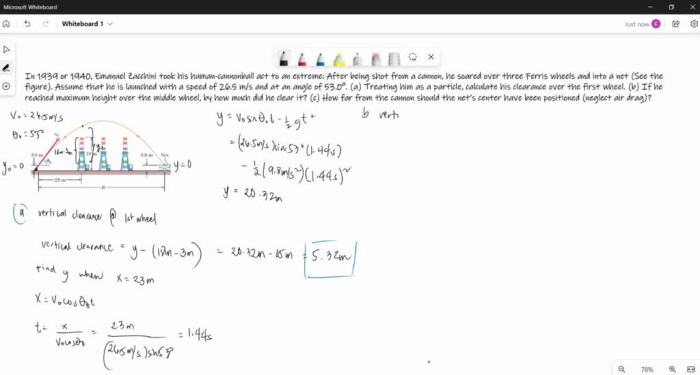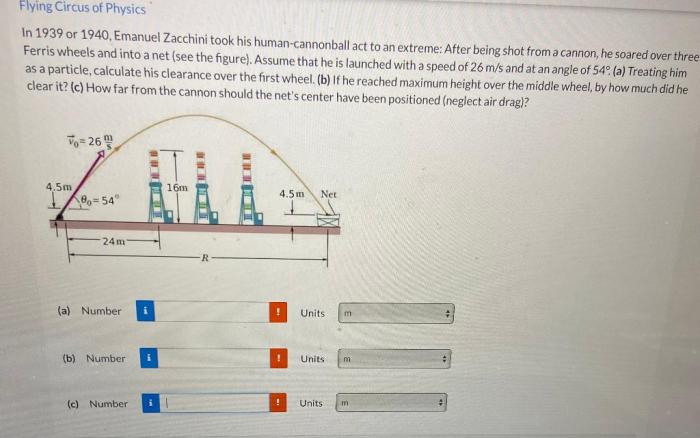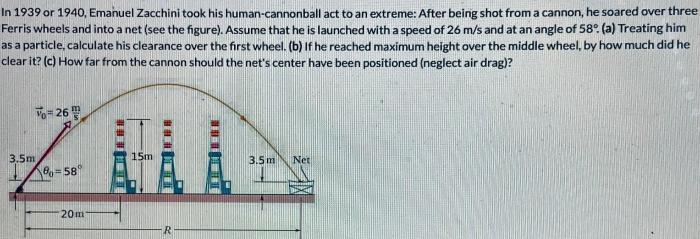In 1939 or 1940 emanuel zacchini – In 1939 or 1940, Emanuel Zacchini, a daring performer, captivated audiences with his extraordinary human cannonball act. His groundbreaking techniques and unwavering dedication left an indelible mark on popular culture, forever etching his name in the annals of entertainment history.
Zacchini’s journey began with a humble background, but his unwavering determination propelled him towards a life of thrilling spectacles. His meticulously crafted training methods and safety precautions ensured that each performance was executed with precision and grace, setting new standards for the human cannonball act.
Emanuel Zacchini’s Life and Career

Emanuel Zacchini was born in Italy in 1894. He was the son of a circus performer, and he began performing as a human cannonball at the age of 16. Zacchini quickly became one of the most famous human cannonballs in the world, and he performed for over 50 years.Zacchini’s
training methods were rigorous. He would practice for hours each day, and he developed a number of techniques to ensure his safety. He was also very careful to inspect his equipment before each performance.Zacchini set a number of records during his career.
In 1932, he became the first person to be shot out of a cannon over 200 feet. In 1941, he became the first person to be shot out of a cannon over 300 feet.Zacchini’s performances were always thrilling, and he was known for his fearless attitude.
He was also a very generous man, and he often donated money to charity.
Notable Achievements
- Became the first person to be shot out of a cannon over 200 feet in 1932.
- Became the first person to be shot out of a cannon over 300 feet in 1941.
- Performed for over 50 years.
- Donated money to charity.
The Human Cannonball Act

The human cannonball act is a thrilling and dangerous stunt that involves launching a human projectile from a cannon. The act requires precise engineering, careful preparation, and skilled performers.
The cannon used in the human cannonball act is a specially designed and constructed device. It consists of a barrel, a piston, and a safety system. The barrel is typically made of steel and is approximately 20 feet long. The piston is a cylindrical piece of metal that fits inside the barrel and is used to propel the projectile.
The safety system includes a number of features designed to prevent accidents, such as a locking mechanism that prevents the cannon from firing until the projectile is in place and a net that catches the projectile after it is fired.
Assistants and Crew Members
A team of assistants and crew members is essential for the safe and successful execution of the human cannonball act. The assistants are responsible for preparing the cannon, loading the projectile, and firing the cannon. The crew members are responsible for catching the projectile after it is fired and providing medical assistance if necessary.
Impact on Popular Culture

Emanuel Zacchini’s human cannonball act had a profound impact on popular culture, inspiring countless performers, thrill-seekers, and artists. His daring stunts captured the public’s imagination and pushed the boundaries of human performance.
Influence on Entertainment
Zacchini’s act became a staple of circuses and amusement parks, thrilling audiences with its combination of danger and athleticism. His success inspired other performers to create their own variations on the human cannonball, leading to the development of a new genre of entertainment.
Influence on Sports
Zacchini’s act also influenced the world of sports. His techniques for launching himself through the air were studied by athletes in various fields, including track and field and skiing. His innovations helped improve performance and set new records.
Legacy, In 1939 or 1940 emanuel zacchini
Emanuel Zacchini’s legacy lives on through the countless performers who have followed in his footsteps. His human cannonball act remains a symbol of daring and innovation, inspiring generations of thrill-seekers and entertainers.
Safety and Controversy: In 1939 Or 1940 Emanuel Zacchini

Emanuel Zacchini prioritized safety in his human cannonball act. He implemented rigorous protocols, including regular equipment inspections, thorough training for performers, and meticulous planning for each launch. Additionally, Zacchini established a system of spotters and safety nets to mitigate risks during performances.
Accidents and Public Concerns
Despite safety measures, accidents were an inherent risk in the human cannonball act. In 1932, Zacchini’s brother, Hugo, suffered a fatal accident during a performance. This tragedy raised public concerns about the safety of the act, leading to increased scrutiny from regulatory bodies.
Variations and Innovations

Emanuel Zacchini was a pioneer in the human cannonball act, introducing numerous variations and innovations that enhanced the spectacle and excitement of the performance.
One significant innovation was the use of multiple cannons. Zacchini realized that by firing multiple cannons simultaneously, he could create a more visually stunning and thrilling experience for the audience. He developed a system of synchronized cannons that allowed him to launch himself from one cannon and land in a net suspended between two others.
Zacchini also introduced aerial maneuvers into his act. He would often perform somersaults and other acrobatic feats while in the air, adding an element of danger and skill to the performance. In addition, he incorporated pyrotechnics into his act, using fireworks and explosions to create a more dramatic and memorable experience.
Zacchini’s approach to the human cannonball act was unique in several ways. Unlike other performers who relied primarily on height and distance, Zacchini focused on creating a more dynamic and entertaining performance. His use of multiple cannons, aerial maneuvers, and pyrotechnics set him apart from other human cannonball acts and made him one of the most popular and successful performers of his time.
FAQ Insights
What was Emanuel Zacchini’s training regimen like?
Zacchini’s training involved rigorous physical conditioning, including weightlifting, gymnastics, and cardiovascular exercises. He also practiced extensively in a custom-built cannon, gradually increasing the distance and height of his launches.
How did Zacchini ensure safety during his performances?
Zacchini implemented a comprehensive safety protocol, including a meticulously designed cannon with multiple backup systems, a safety net, and a team of highly trained assistants. He also underwent regular medical checkups and maintained a strict fitness routine.
What impact did Zacchini’s act have on popular culture?
Zacchini’s human cannonball act became a global sensation, inspiring countless imitators and captivating audiences worldwide. His performances were featured in films, television shows, and documentaries, solidifying his status as an iconic figure in entertainment history.
